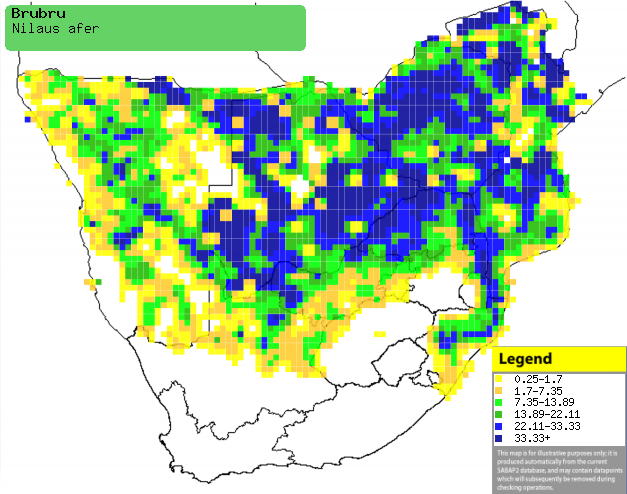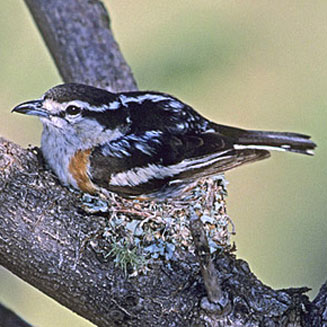|
Nilaus afer (Brubru)
Bontroklaksman [Afrikaans]; Broebroe [Dutch]; Brubru
africain [French]; Brubru [German]; Brubru [Portuguese]
Life
> Eukaryotes >
Opisthokonta
> Metazoa (animals) >
Bilateria >
Deuterostomia > Chordata >
Craniata > Vertebrata (vertebrates) > Gnathostomata (jawed
vertebrates) > Teleostomi (teleost fish) > Osteichthyes (bony fish) > Class:
Sarcopterygii (lobe-finned
fish) > Stegocephalia (terrestrial
vertebrates) > Tetrapoda
(four-legged vertebrates) > Reptiliomorpha > Amniota >
Reptilia (reptiles) >
Romeriida > Diapsida > Archosauromorpha > Archosauria >
Dinosauria
(dinosaurs) > Saurischia > Theropoda (bipedal predatory dinosaurs) >
Coelurosauria > Maniraptora > Aves
(birds) >
Order: Passeriformes
> Family: Malaconotidae
Distribution and habitat
Widespread in sub-Saharan Africa, absent only from the
southern half of South Africa (including the Western, Eastern and Northern
Capes) and the lowland forest in and around the DRC and West African coast. In
southern Africa it generally prefers Acacia savanna, Miombo woodland and
Mopane woodland, occasionally occurring in more arid habitats
|
 |
|
Distribution of Brubru in southern Africa,
based on statistical smoothing of the records from first SA Bird Atlas
Project (©
Animal Demography unit, University of
Cape Town; smoothing by Birgit Erni and Francesca Little). Colours range
from dark blue (most common) through to yellow (least common).
See here for the latest distribution
from the SABAP2. |
Food
It mainly eats arthropods, doing most of its foraging in
the canopies of trees, gleaning prey from leaves and branches. It also hawks
prey aerially and sometimes joins mixed species foraging flocks along with other
passerines.
Breeding
- Both sexes build the nest, which is a small, neat cup made of fine plant
material such as twigs, tendrils and bark held together with spider web.
 |
|
|
Brubru incubating its eggs, Nylsvley area, South
Africa. [photo Warwick Tarboton ©] |
|
- Egg-laying season is from about August-January.
- It lays 1-3, usually 2 eggs which are incubated by both sexes for about
19 days.
- The chicks are brooded constantly for the first week of their lives,
after which brooding periods become more and more sporadic. The chicks
eventually leave the nest at about 20-22 days old, becoming fully
independent roughly 8 weeks later.
Threats
Not threatened.
References
-
Hockey PAR, Dean WRJ and Ryan PG 2005. Roberts
- Birds of southern Africa, VIIth ed. The Trustees of the John Voelcker
Bird Book Fund, Cape Town.
|
